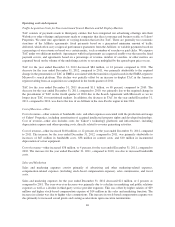Yahoo 2012 Annual Report Download - page 60
Download and view the complete annual report
Please find page 60 of the 2012 Yahoo annual report below. You can navigate through the pages in the report by either clicking on the pages listed below, or by using the keyword search tool below to find specific information within the annual report.Operating costs and expenses
Traffic Acquisition Costs for Non-transitioned Search Markets and All Display Markets
TAC consists of payments made to third-party entities that have integrated our advertising offerings into their
Websites or other offerings and payments made to companies that direct consumer and business traffic to Yahoo!
Properties. We enter into agreements of varying duration that involve TAC. There are generally two economic
structures of the Affiliate agreements: fixed payments based on a guaranteed minimum amount of traffic
delivered, which often carry reciprocal performance guarantees from the Affiliate, or variable payments based on
a percentage of our revenue or based on a certain metric, such as number of searches or paid clicks. We expense
TAC under two different methods. Agreements with fixed payments are expensed ratably over the term the fixed
payment covers, and agreements based on a percentage of revenue, number of searches, or other metrics are
expensed based on the volume of the underlying activity or revenue multiplied by the agreed-upon price or rate.
TAC for the year ended December 31, 2012 decreased $84 million, or 14 percent, compared to 2011. The
decrease for the year ended December 31, 2012, compared to 2011, was primarily attributable to the required
change in the presentation of TAC in EMEA associated with the transition of paid search in the EMEA region to
Microsoft’s search platform. This decline was partially offset by an increase in display TAC in the Americas
region resulting from an acquisition we completed in the fourth quarter of 2011.
TAC for the year ended December 31, 2011 decreased $1.1 billion, or 65 percent, compared to 2010. The
decrease for the year ended December 31, 2011, compared to 2010, was primarily due to the required change in
the presentation of TAC in the fourth quarter of 2010 due to the Search Agreement with Microsoft as we no
longer incur TAC for transitioned markets. In addition, the decrease in TAC for the year ended December 31,
2011, compared to 2010, was due to the loss of an Affiliate in the Asia Pacific region in late 2010.
Cost of Revenue—Other
Cost of revenue—other consists of bandwidth costs, and other expenses associated with the production and usage
of Yahoo! Properties, including amortization of acquired intellectual property rights and developed technology.
Cost of revenue—other also includes costs for Yahoo!’s technology platforms and infrastructure, including
depreciation expense and other operating costs, directly related to revenue generating activities.
Cost of revenue—other increased $118 million, or 12 percent, for the year ended December 31, 2012, compared
to 2011. The increase for the year ended December 31, 2012, compared to 2011, was primarily attributable to
increases of $67 million in bandwidth costs, $38 million in content costs, and $10 million in incremental
depreciation of server equipment.
Cost of revenue—other increased $38 million, or 4 percent, for the year ended December 31, 2011, compared to
2010. The increase for the year ended December 31, 2011, compared to 2010, was due to increased bandwidth
costs.
Sales and Marketing
Sales and marketing expenses consist primarily of advertising and other marketing-related expenses,
compensation-related expenses (including stock-based compensation expense), sales commissions, and travel
costs.
Sales and marketing expenses for the year ended December 31, 2012 decreased $21 million, or 2 percent, as
compared to 2011. The year-over-year decrease was primarily due to a decline in marketing and public relations
expenses as well as a decline in third-party service provider expenses. This was offset by higher salaries of $29
million and higher stock-based compensation expense of $14 million in the sales and marketing function. The
increase in salaries was due to higher sales commissions. The increase in stock-based compensation expense was
due primarily to increased award grants and vesting accelerations upon executive terminations.
46
























